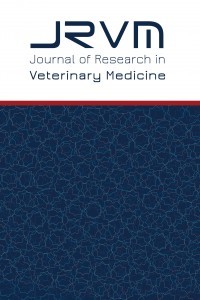Determination of the effect of green extraction solvents on the phenolic acids and flavonoids of propolis
The present study investigated the extraction of phenolic compounds from propolis according to solvent factor. The propolis samples were extracted in four different solvents, which water, ethanol-water (70%), dimethyl sulfoxide (DMSO), and L-lysine (8%), and were analyzed 36 phenolic compounds by HPLC-DAD. Statistically significant differences in solubility of the phenolic compound at various levels were detected among the solvents (P
Keywords:
Propolis extraction, Water, Ethanol, DMSO L-lysine, Phenolic compound.,
___
- 1. Sorucu A, Oruç HH. Determination of biologically active phenolic compounds in propolis by LC–MS/MS according to seasons and altitudes. J. Food Meas. Charact. 2019;13(3):2461-2469.
- 2. Pasupuleti VR, Sammugam L, Ramesh N, Gan SH. Honey, propolis, and royal jelly: a comprehensive review of their biological actions and health benefits. Oxidative Med. Cell. Longev. 2017;2017.
- 3. Zabaiou N, Fouache A, Trousson A, et al. Biological properties of propolis extracts: Something new from an ancient product. Chem. Phys. Lipids. 2017;207:214-222.
- 4. Walker P, Crane E. Constituents of propolis. Apidologie. 1987;18(4):327-334.
- 5. Banskota AH, Tezuka Y, Kadota S. Recent progress in pharmacological research of propolis. Phytother. Res. 2001;15(7):561-571.
- 6. Bankova V, Popova M, Trusheva B. Propolis volatile compounds: chemical diversity and biological activity: a review. Chem. Cent. J. 2014;8(1):28.
- 7. Park YK, Ikegaki M. Preparation of water and ethanolic extracts of propolis and evaluation of the preparations. Biosci Biotech Bioch. Nov 1998;62(11):2230-2232.
- 8. Toreti VC, Sato HH, Pastore GM, Park YK. Recent progress of propolis for its biological and chemical compositions and its botanical origin. eCAM. 2013;2013.
- 9. Trusheva B, Trunkova D, Bankova V. Different extraction methods of biologically active components from propolis: a preliminary study. Chem. Cent. J. 2007;1(1):13.
- 10. Oruç HH, Sorucu A, Ünal HH, Aydin L. Effects of season and altitude on biological active certain phenolic compounds levels and partial standardization of propolis. Ankara Univ Vet Fak Derg. 2017;64(1):13-20.
- 11. Kubiliene L, Laugaliene V, Pavilonis A, et al. Alternative preparation of propolis extracts: comparison of their composition and biological activities. BMC Complem. Altern. M. 2015;15(1):156.
- 12. Volpi N, Bergonzini G. Analysis of flavonoids from propolis by on-line HPLC–electrospray mass spectrometry. J. Pharm. Biomed. Anal. 2006;42(3):354-361.
- 13. Pujirahayu N, Ritonga H, Uslinawaty Z. Properties and flavonoids content in propolis of some extraction method of raw propolis. Int J Pharm Pharm Sci. 2014;6:338-340.
- 14. Silva JC, Rodrigues S, Feás X, Estevinho LM. Antimicrobial activity, phenolic profile and role in the inflammation of propolis. Food Chem Toxicol. 2012;50(5):1790-1795.
- 15. Carvalho AA, Finger D, Machado CS, et al. In vivo antitumoural activity and composition of an oil extract of Brazilian propolis. Food Chem. 2011;126(3):1239-1245.
- 16. Ramanauskienė K, Inkėnienė AM, Petrikaitė V, Briedis V. Total phenolic content and antimicrobial activity of different Lithuanian propolis solutions. eCAM. 2013;2013.
- 17. Umthong S, Phuwapraisirisan P, Puthong S, Chanchao C. In vitro antiproliferative activity of partially purified Trigona laeviceps propolis from Thailand on human cancer cell lines. BMC Complem. Altern. M. May 6 2011;11.
- 18. Ugur A, Arslan T. An in vitro study on antimicrobial activity of propolis from Mugla province of Turkey. J. Med. Food. Spr 2004;7(1):90-94.
- 19. Galvao J, Davis B, Tilley M, Normando E, Duchen MR, Cordeiro MF. Unexpected low-dose toxicity of the universal solvent DMSO. The FASEB Journal. 2014;28(3):1317-1330.
- 20. Rocha BA, Bueno PCP, Vaz MMDLL, et al. Evaluation of a Propolis Water Extract Using a Reliable RP-HPLC Methodology and In Vitro and In Vivo Efficacy and Safety Characterisation. eCAM. 2013.
- 21. Dornelas CA, Fechine-Jamacaru FV, Albuquerque IL, et al. Chemoprevention with green propolis green propolis extracted in L- lysine versus carcinogenesis promotion with L-lysine in N-Butyl-N-[4-hydroxybutyl] nitrosamine (BBN) induced rat bladder cancer. Acta Cir Bras. Feb 2012;27(2):185-192.
- 22. Funari CS, Sutton AT, Carneiro RL, et al. Natural deep eutectic solvents and aqueous solutions as an alternative extraction media for propolis. Food Res Int. Nov 2019;125.
- 23. Yang L, Yan Q-H, Ma J-Y, Wang Q, Zhang J-W, Xi G-X. High performance liquid chromatographic determination of phenolic compounds in propolis. Trop. J. Pharm. Res. 2013;12(5):771-776.
- 24. Cottica SM, Sawaya AC, Eberlin MN, Franco SL, Zeoula LM, Visentainer JV. Antioxidant activity and composition of propolis obtained by different methods of extraction. J. Braz. Chem. Soc. 2011;22(5):929-935.
- 25. Mello BC, Hubinger MD. Antioxidant activity and polyphenol contents in B razilian green propolis extracts prepared with the use of ethanol and water as solvents in different p H values. Int. J. Food Sci. Technol. 2012;47(12):2510-2518.
- 26. Sun CL, Wu ZS, Wang ZY, Zhang HC. Effect of Ethanol/Water Solvents on Phenolic Profiles and Antioxidant Properties of Beijing Propolis Extracts. eCAM. 2015.
- 27. Çakıroğlu TN. Investigation of solubility of Turkish propolis in different solvents. Karadeniz Tecnical University, Biochemistry Master Thesis. 2010.
- 28. Sun C, Wu Z, Wang Z, Zhang H. Effect of ethanol/water solvents on phenolic profiles and antioxidant properties of Beijing propolis extracts. eCAM. 2015;2015.
- 29. Bakkaloğlu Z, Arıcı M. Farklı çözücülerle propolis ekstraksiyonunun toplam fenolik içeriği, antioksidan kapasite ve antimikrobiyal aktivite üzerine etkileri. Akademik Gıda. 2019;17(4):538-545.
- 30. Bayram NE, Gerçek YC, Bayram S, Toğar B. Effects of processing methods and extraction solvents on the chemical content and bioactive properties of propolis. J. Food Meas. Charact. 2020;14(2):905-916.
- 31. Bonvehí JS, Gutiérrez AL. Antioxidant activity and total phenolics of propolis from the Basque Country (Northeastern Spain). J. Am. Oil Chem. Soc. 2011;88(9):1387-1395.
- 32. Kubiliene L, Jekabsone A, Zilius M, et al. Comparison of aqueous, polyethylene glycol-aqueous and ethanolic propolis extracts: antioxidant and mitochondria modulating properties. BMC Complem. Altern. M. 2018;18(1):165.
- 33. Liu Z, Ding L, Zhang H, Hu X, Bu F. Comparison of the Different Extraction Methods of Flavonoids in Epimedium Koreamum Nakai by HPLC‐DAD‐ESI‐MS. J. Liq. Chromatogr. Relat. Technol. 2006;29(5):719-731.
- Başlangıç: 1981
- Yayıncı: Bursa Uludağ Üniversitesi
